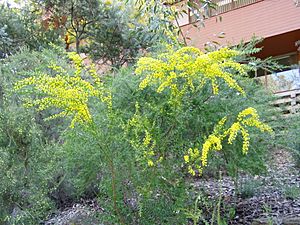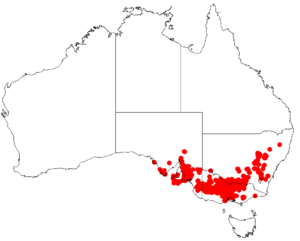Gold dust wattle facts for kids
Quick facts for kids Gold dust wattle |
|
|---|---|
 |
|
| Scientific classification | |
| Genus: |
Acacia
|
| Species: |
acinacea
|
 |
|
| Occurrence data from AVH | |
The Gold Dust Wattle (scientific name: Acacia acinacea) is a beautiful flowering shrub. It grows naturally in southeastern Australia. This plant can live for about 15 years. It is very tough and can handle both dry weather (drought) and cold temperatures (frost).
You might also hear it called Wreath Wattle or Round-leaf Wattle. It is a type of wattle plant.
What Does It Look Like?
The Gold Dust Wattle is a shrub that can grow up to about 2.5 meters (8 feet) tall. It can look either bushy or a bit spread out. Its small branches might be smooth or slightly hairy.
Instead of regular leaves, most wattle plants, including this one, have special leaf-like parts called phyllodes. These phyllodes are usually smooth or a little hairy. They stay green all year round. They can be shaped like an oval, a wide egg, or even a circle. Each phyllode is about 0.4 to 1.5 centimeters long and 2 to 8 millimeters wide. They don't have a clear middle vein like many leaves do.
This wattle blooms a lot, usually between July and November. Its flowers are bright golden and grow in small, round balls. Each flower ball is about 4 to 4.5 millimeters across and has 8 to 20 tiny flowers.
After the flowers bloom, smooth seed pods appear. These pods are hard and often twisted into a spiral or irregular shape. They are about 3 to 4.5 millimeters wide. Inside, you'll find shiny, dark brown seeds. Each seed is about 4 to 5 millimeters long and has a small, club-shaped attachment called an aril. This aril can be half as long as the seed itself.
How It Was Named
The Gold Dust Wattle was first officially described in 1838. A botanist named John Lindley wrote about it. He included it in a book by Thomas Mitchell called Three Expeditions into the interior of Eastern Australia.
This plant has had a few different scientific names over time, but Acacia acinacea is the one used now.
The name acinacea comes from a Latin word for a short Persian sword. This name was chosen because the phyllodes (the leaf-like parts) of the plant are shaped a bit like that sword.
Where Does It Grow?
The Gold Dust Wattle is found only in certain parts of Australia. It is very common in most of Victoria, southeastern South Australia, southeastern New South Wales, and the Australian Capital Territory.
You can often find it growing in hilly areas. It likes to grow in sandy, gravelly, or loamy soils that drain water well. It is part of different plant communities, such as Eucalyptus woodlands and open mallee scrubland.
This wattle is a very tough plant that produces many flowers. While it can handle many different soil types, it prefers soil that is well-drained and not salty.
See also
 In Spanish: Acacia acinacea para niños
In Spanish: Acacia acinacea para niños

